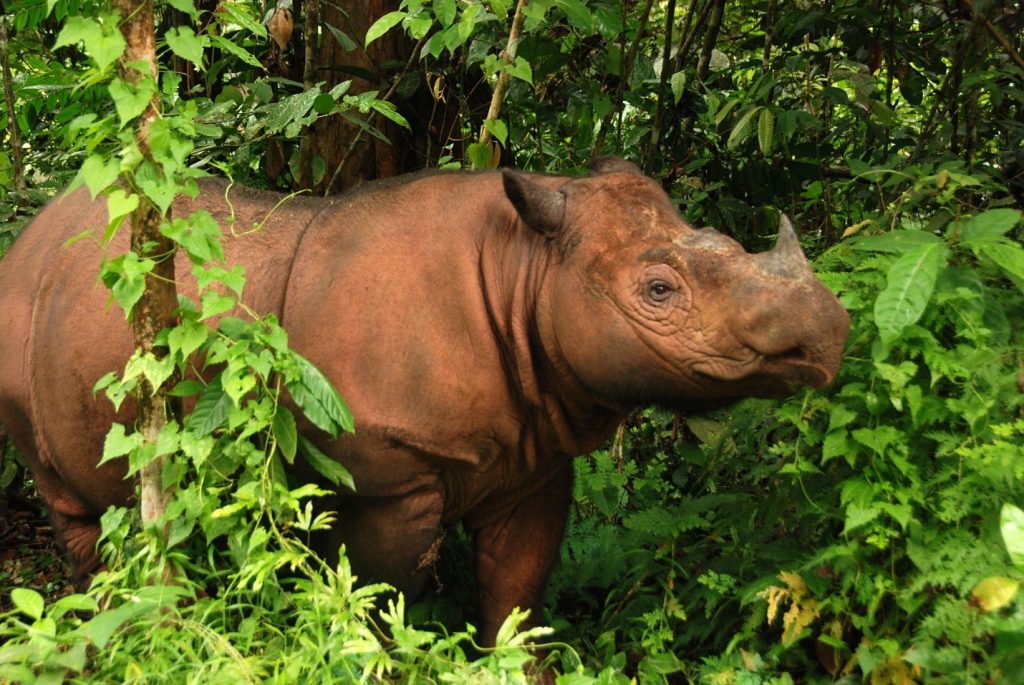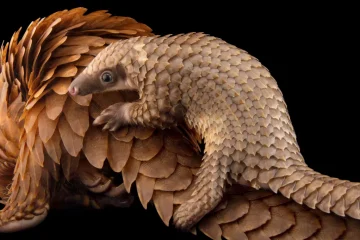Inherited “horned nose” defines the Greek name rhinoceros. They are large mammals belonging to the Hinocerotidae family. Even if it has been discovered nearly 100 known rhinoceros species have existed throughout centuries, only five of those can be found currently in Africa and Asia. The black rhino (Diceros bicornis) and the white rhino (Ceratotherium simum) are the two African species where the Sumatran rhino (Dicerorhinus sumatrensis), the Javan rhino (Rhinoceros sondaicus), and the greater one-horned rhino (Rhinoceros unicornis) are the three Asian species. It is tragic to believe as few as 27,000 rhinos remain in the wild by now where three species of them (black, Javan, and Sumatran) are critically endangered due to persistent poaching for their horns and habitat loss and degradation over many decades.
Appearance to be specified of these giant creatures, their horns are the most notable feature. Rhinos are born without horns, and once they grow after about 2 months, they continue to grow for the rest of their lives. The number of horns a rhino has varies with its species. These magnificent giants are extremely agile herbivores, having small brains relative to their size.
The Rhino Family
- Black Rhino (Diceros bicornis)
Being the smallest among the two African species, black rhinos can be distinguished by their hooked upper lips which help them feed on leaves from bushes and trees. They have two horns; the front horn is longer than the rear horn, averaging around 19 inches long. With an average height of 5.2 feet a grown black rhino weighs around 1,760-3,080 pounds. They are mostly solitary and territorial and can be found in semi-desert savannahs, woodlands, forests, and wetlands in the African region as the arid northern western parts of Namibia are the home to its largest free-roaming black rhino population. Black rhinos remain critically endangered with a current population of 6,000 even with the persistent conservation efforts across Africa.

2. White Rhino
Being known as the square-lipped rhinoceros, white rhinos are the second-largest land mammal. Two genetically different subspecies exist, the northern and southern white rhino, and are found in two different regions in Africa having complex social structures. The majority (98.8%) of the southern white rhinos occur in South Africa, Namibia, Zimbabwe, and Kenya. They are now classified as Near Threatened with around 18,000 population.

3. Greater One-Horned Rhino (Rhinoceros unicornis)
This is the largest of the rhino species also known as the “Indian rhino” as they were once widespread across the entire northern part of the Indian sub-continent. The greater one-horned rhino is identified by a single black horn about 8-25 inches long and a grey-brown hide with skin folds, which gives it an armor-plated appearance. With a weight range between 4000-6000 pounds, they usually grow up to 5.75-6.5 feet in height and 10-12.5 feet in length. This species is solitary, except when adult males or rhinos nearing adulthood gather at wallows or graze with a diet consisting almost entirely of grasses as well as leaves, branches of shrubs and trees, fruit, and aquatic plants. By today their populations have increased to around 4,000 rhinos in northeastern India and the Teral grasslands of Nepal from around 200 remained at the beginning of the 20th century.

4. Javan Rhino (Rhinoceros sondaicus)
Being the most threatened among all, the population with only around 60 individuals in Ujung Kulon National Park in Java represents the only hope for the survival of this species that is on the brink of extinction. This species is dusky grey and has a single horn of up to about 10 inches. They grow up to 4.6-5.8 feet in height and 10-10.5 feet in length with a weight range of 1984-5071 pounds. Its skin has a few loose folds, giving the appearance of armor plating. They are very similar in appearance to the closely related greater one-horned rhinoceros but have a much smaller head and less apparent skin folds. It is mentioned that low genetic diversity and inbreeding could make it difficult for the long-term survival of the species.

5. Sumatran Rhino (Dicerorhinus sumatrensis)
This species is the smallest of the living rhinoceroses and the only Asian rhino with two horns. They are covered with long hair and are more closely related to the extinct woolly rhinos than any of them alive today. Calves are born with a dense covering that turns reddish-brown in young adults and becomes sparse, bristly, and almost black in older animals. Even while surviving in possibly greater numbers (including about 30 mature individuals) than the Javan rhino, they are competing for the unenviable title of most threatened rhino species. Today this species only survives on the Indonesian Islands of Sumatra and Borneo.

Interesting Facts:
- Rhinos are partially blind. They can barely see objects 98 feet away from them.
- Rhinos’ horns are made of keratin, not bones.
- The chubbiest rhino is called a unicorn and is built like a knight in shining armor.
- Like humans, a rhino’s skin can be very sensitive and can be burnt.
- A group of rhinos is called a crash.
- Rhinos are one of the only three mammals that cannot jump!
Rhinos are one of the oldest groups of mammals, virtually living fossils. They share their homes with a multitude of other valuable plants and animals. The enormous reduction in the range of rhinos was mainly caused by the disappearance of alluvial plain grasslands. As they need large territories to survive, their protection benefits many other species that live in the area and keeps ecosystems healthy. Rhinos contribute to economic growth and sustainable development through the tourism industry, which creates job opportunities and provides tangible benefits to local communities living alongside rhinos.
Rhinos have no natural predators except humans. World Rhino Day is celebrated annually on the 22nd of September emphasizing the need to fight against these wildlife criminals, both in Africa as well where their horns end up in Asia.
Written by:
Apoorwa Amarathunga
2nd Year Undergraduate,
Physical Science Stream,
Faculty of Science,
University of Colombo.
References:
- NATURE, PBS. (2020, August 27). Rhinoceros Fact Sheet | Blog | Nature | PBS. Nature. https://www.pbs.org/wnet/nature/blog/rhinoceros-fact-sheet/
- Rhino | Species | WWF. (n.d.). World Wildlife Fund. https://www.worldwildlife.org/species/rhino
- Ward, L. (2021). 20 Fascinating facts about rhinos that you should know. The Fact Site. https://www.thefactsite.com/rhino-facts/
Image Courtesy:
- Title image: https://biturl.top/R7V7Fr
- 1st Content Image: https://biturl.top/iyEN32
- 2nd Content Image: https://biturl.top/ym2imm
- 3rd Content Image: https://biturl.top/jAvMba
- 4th Content Image: https://biturl.top/vABzEz
- 5th Content Image: https://biturl.top/VFv6Nj



0 Comments